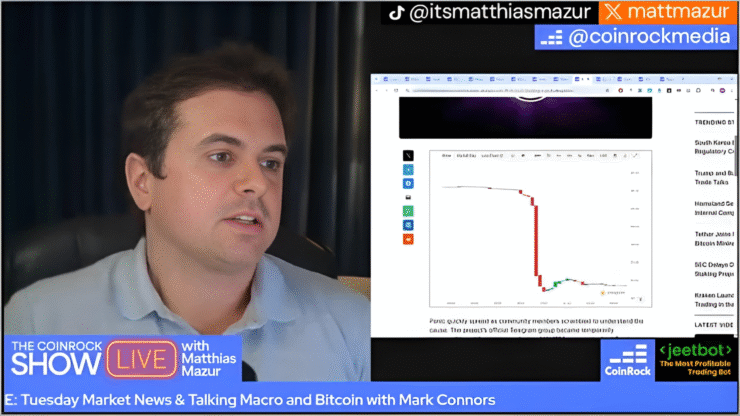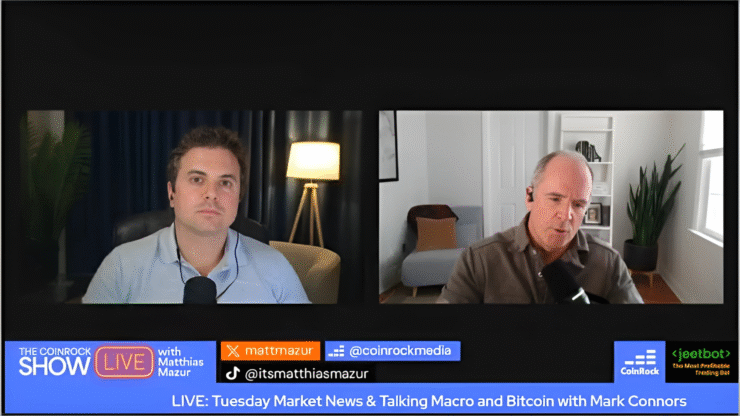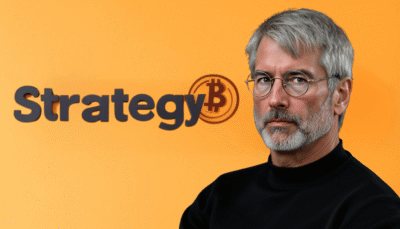Bitcoin held steady on a tense Tuesday, while Ethereum and the broader crypto market nudged slightly upward—grinding through what Matthias described as a “choppy range” that will remain for a while “until we have a next”. It was a market in limbo, waiting on macro clarity, and The CoinRock Show opened with a clear-eyed look at that uncertainty.
Matthias Mazur, ever the steady navigator, walked viewers through the current state of play: bond yields reacting to Trump’s 90-day tariff pause, traders watching the Fed’s next move like hawks, and risk assets—crypto included—showing signs of cautious optimism. But as he reminded the audience, structural fragility hasn’t disappeared.
“A very strong crypto network now, some of the OGs of the space openly admit this cycle is very confusing for them,” he said.
They’ve been through all the cycles since 2009, 2010, and it’s not easy. This cycle is very difficult because everything is dependent on really Trump and the policies and the tariffs.”
Bitcoin traded just under $84,000. Ethereum hovered near $1,600. Altcoins were up, but mostly following beta, not fundamentals. More telling was the movement in the bond market and the MOVE Index, which Matthias pointed to as the real heartbeat of macro risk.
“Remember, the crypto industry is tiny, relative, right? When you compare it to the real estate market, the bond market, even gold.,” he explained

The early segment set the tone: markets may be stagnant, but the macro undercurrents are far from stable. And that led perfectly into one of the show’s most timely and insightful conversations yet—with Wall Street veteran Mark Connors.
Mark Connors Brings the Macro Heat
On Tuesday’s episode, host Matthias sat down with Mark Connors, a 35-year Wall Street veteran, macro risk strategist, and author behind the widely followed “Risk Dimensions” Substack.
The episode delivered one of the most grounded and illuminating macro breakdowns in recent crypto media—offering sobering insight into the U.S. debt spiral, rate policy, global liquidity shifts, and why Bitcoin is no longer just a hedge, but a necessary escape hatch from financial dysfunction.
“They [the Feds] are going to continue to light fires and put them out until we have a debt load that I don’t know what the end game is except to own Bitcoin,” Connors explained.
QT, QE, and the Illusion of Control
Connors wasted no time deconstructing what many crypto traders misunderstand about interest rates and monetary policy. His view? The Fed is out of long-term options.
“The government had to figure it out. So they had to bail out. And to me, that was still the most unheard bell that has rung and changed everything,” he said, referring to the shift post-2008 where private market defaults were replaced by government bailouts and debt accumulation.
“Now the liabilities are at the US government and they can’t fail. So they’ll continue to print money.”
In a clear, digestible breakdown, Connors walked listeners through Quantitative Tightening (QT) and Quantitative Easing (QE)—and why both are now political tools more than economic ones. The U.S. is stuck with a growing interest bill and shrinking flexibility, with more than a third of its $34.6 trillion debt maturing within 12 months.
This inflation of debt without structural growth leaves only one exit: inflate your way out—debase the dollar, slow-walk rate hikes, and let assets like Bitcoin and hard commodities silently eat the downside.

One of the episode’s most powerful metaphors came when Connors likened America’s fiscal position to a household with $125,000 in credit card debt on a $100,000 salary—with no intention of cutting spending.
“Our rate of debt went up so high, faster than our ability to earn out of it,” he said.
“We now have the bends. We’re getting hallucinating. We’re experiencing pain from accelerating into a degree of debt that our revenue have not caught up to.”
He argued that the U.S. has already reached the “bends” — an analogy borrowed from scuba diving — where the ascent into high-rate environments has been too sharp, too fast. The U.S. now has no choice but to keep money cheap, even if inflation lingers or worsens.
One surprising insight came in the form of a financial metric most in crypto have never heard of: the MOVE Index, which tracks Treasury market volatility.
A spike in MOVE signals bond market instability, and a potential loss of confidence in U.S. debt. Connors warned that if Treasury auctions begin to fail, it could force the Fed into stealth QE — essentially re-entering the bond market to prevent collapse.
Trump’s Tariff Ping-Pong and the Fragile Balance
The conversation also touched on Trump’s tariff reversals and how the market reacts to fiscal policy uncertainty. Connors described it as “an absolute game of chicken” where policy is now trialed in public, gauging real-time market reactions before formalizing moves.
In that context, the back-and-forth on tariffs directly impacts bond yields, risk appetite, and by extension, crypto prices.
“I think they would do much better being interested in the macro and in everything we talked about, because it changes every day,” said Matthias.
“We could have this podcast tomorrow and Trump could tweet out something 10 minutes before the podcast and the conversation changes completely. So it’s so fluid.”
While most macro analysts still treat Bitcoin as a speculative hedge, Connors was clear: Bitcoin is becoming infrastructure.
“I don’t mention price a lot. I just talk about the fact that it’s a decentralized technology network and every business that’s surviving is a network based on the internet,” he said
“Gold is not. Our banking system is not. Effectively, it’s creaking and broken and requires leverage to survive. You know, Bitcoin doesn’t. So I am getting louder though.”
He noted that players like Paul Tudor Jones and even U.S. Treasury officials are starting to position accordingly—not as speculation, but as insurance against systemic failure.
Final Take: Gradually, Then Suddenly
If there was one theme that echoed throughout the episode, it was this: the system is fragile, interconnected, and inflating by design. Connors wasn’t alarmist, but he made it clear that the rules have changed.
“Instead of price, what would I look at? I really want to see other corporations other than Michael Saylor buying..”
And in a world where inflation is the only politically viable solution, assets like Bitcoin are no longer a rebellion—they’re a necessity.
Where You Can Find Mark Connors
You can follow Mark Connors and explore more of his macro insights, financial commentary, and crypto-market breakdowns through the platforms below:
- Twitter: @riskdimensions
- Substack: Risk Dimensions by Mark Connors
- LinkedIn: Mark Connors




